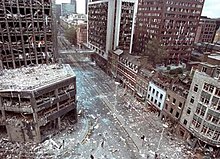| 1993 Bishopsgate bombing | |
|---|---|
| Part of the Troubles | |
 Wormwood Street pictured in the aftermath of the bombing which occurred on nearby Bishopsgate | |
| Location | Bishopsgate, London, United Kingdom |
| Coordinates | 51°30′56″N 0°04′56″W / 51.5156°N 0.0822°W |
| Date | 24 April 1993 10:27 am (GMT) |
| Target | London's primary financial district |
Attack type | Truck bomb |
| Deaths | 1 |
| Injured | 44[1] |
| Perpetrators | Provisional Irish Republican Army |
The Bishopsgate bombing occurred on 24 April 1993, when the Provisional Irish Republican Army (IRA) detonated a powerful truck bomb on Bishopsgate, a major thoroughfare in London's financial district, the City of London. Telephoned warnings were sent about an hour beforehand, but a news photographer was killed in the blast and 44 people were injured, with fatalities minimised due to its occurring on a Saturday. The blast destroyed the nearby St Ethelburga's church and wrecked Liverpool Street station and the NatWest Tower.[2][3]
As a result of the bombing, which happened just over a year after the bombing of the nearby Baltic Exchange, a "ring of steel" was implemented to protect the City, and many firms introduced disaster recovery plans in case of further attacks or similar disasters. £350 million (equivalent to £710 million in 2023) was spent on repairing damage. In 1994 detectives believed they knew the identities of the IRA bombers, but lacked sufficient evidence to arrest them.[4]
- ^ "Bishopsgate bomb: Photos issued on 25th anniversary". BBC News. 24 April 2018. Retrieved 14 April 2023.
- ^ "BBC ON THIS DAY | 24 | 1993: IRA bomb devastates City of London". BBC News. 24 April 1993. Archived from the original on 27 April 2009. Retrieved 18 May 2018.
- ^ "Bomb disposal hero breaks silence on anniversary of Bishopsgate blast | London Evening Standard". Standard.co.uk. 25 April 2013. Archived from the original on 18 April 2018. Retrieved 18 May 2018.
- ^ Kirby, Terry (5 April 1994). "Police 'know who planted Bishopsgate bomb': Men seen on video may be in Irish Republic. Terry Kirby reports". The Independent. Archived from the original on 18 April 2018. Retrieved 18 May 2018.